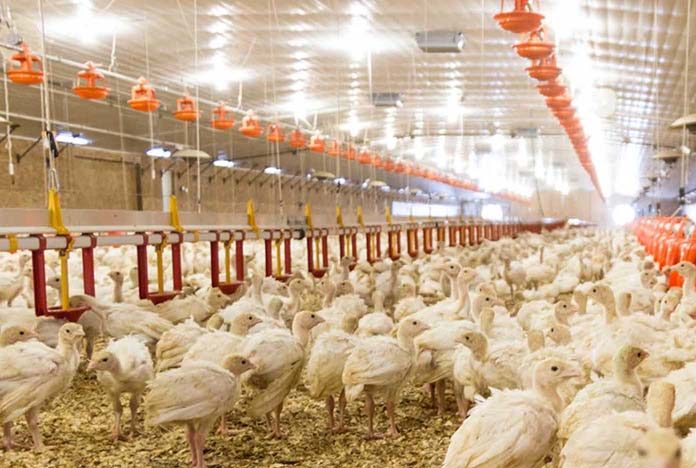
Nocardiosis is an opportunistic, noncontagious, pyogranulomatous or suppurative disease of domestic animals, wildlife and people. In domestic animals, it causes mastitis, pneumonia (granulomatous lesions in lungs), abscesses and cutaneous lesions.
Nocardia species are aerobic actinomycetes that belong to order Actinomycetales which comprises a complex group of pathogens like Mycobacterium and Corynebacterium. They are refractory to conventional treatment. Nocardia are widely distributed in the soil, organic material, fresh water, salt water, dust and other environmental sources. In domestic animals at least 30 species of Nocardia have been described as responsible for various syndromes.
Nocardiosis is considered an uncommon disease in animals and people, however reports of animal nocardiosis have increased worldwide. This organism has rarely been isolated from domestic poultry. There were only reports of isolation from ducks, pigeons (Swayne 2013) and parrots. Chickens are susceptible to experimental infection after oral or intraperitoneal inoculation. In the present paper, a first case of Nocardiosis in turkey poults has been described.
Case history and diagnostic analyses
A flock of 12,000 toms, from commercial farm reported increased mortality in the first week of brooding. Poults were brooded on pine shavings. At five days mortality reached 7.2%. After first week mortality was declining without medication and at the end of second week was at 9.5%. The sick birds were depressed and some showing respiratory distress. The sister flock of hens from the same hatch brooded on different farm had no disease problemand mortality was at normal level. Post-mortem examination has been done on 15, 5day-old poults. Ten poults had a striking lesions in lungs and kidneys. Lungs were congested with multiple grey granulomas. Kidneys had large pale areas distinct from normal tissue. Livers and spleens were congested. The other 5 poults hadlesions consisted with starvation.
Bacteriological examinations
Lungs and livers were cultured on standard media of blood agar, McConkey and Sabouraud agar. After 48 hours there were only single colonies of E.coli. Longer incubation time was not performed.
Histopathology
In lungs there were multiple large areas of necrosis and inflammation within the pulmonary parenchyma with central cores of necrosis, inflammatory cell debris and fibrin exudation surrounded by poorly defined rims of macrophages and multinucleated giant cells. Within parabronchi were extra macrophages, multinucleated giant cells, proteinaceous fluid and fibrin. Occasional small vessels contained fibrin and thrombi. There were moderate congestion of the lung peripheral to the granulomas. In kidneys there were large areas of necrosis and inflammation surrounded by macrophages and multinucleated giant cells.
Lung sections stained with Gram Stain showed numerous filamentous branching bacteria within granulomas. These bacteria did not stain consistently with the Gram Stain.
The PAS stain sections of pulmonary granulomas did not have any fungal hyphae. On modified acid fast FITE stain there were visible long filamentous bacteria but not allwere visibly and strongly stained.
PCR testing and 16 S rRNA sequencing
Scrolls of lung granulomas were collected for PCR testing and sequencing. The PCR testing and sequencing showed that the bacteria belonged to Nocardia. The sequencing revealed that the isolate has 100% identity to two species Nocardia farcinica and Nocardia otitidiscaviarum. These two species are closely related.
Discussion
To date in the literature, there have not been descriptions of any cases of Nocardiosis in turkeys. There is only one paper (Okoye 1991) describing experimental infection of chickens with N. asteroids and N. transvalensis. Ten day old chicks infected orally and intraperitoneally were susceptible to infection. The clinical signs (depression, gasping) were most severe in the birds infected peritoneally. Three out of 10 chickens died. In our case the infection was self-limiting. Mortality stopped after 3 weeks without medication. One can speculate that infection was by inhalation due to contaminated shavings. Nocardia are quite resistant to medication and the drugs of choice are Sulfonamides with long periods of treatment.
We were not able to isolate these Nocardia species using standard media and 48 hrs incubation time. In the literature they recommend very long incubation up to 2 weeks at temperature 37 – 43 °C, since the growth of Nocardia spp in culture media is slow (Merck Manual, Pal 1997, Lerner 1996). The second attempt to isolate Nocardia by culture was not possible since the samples were not available.
Histopathological sections were stained with Gram stain and Fite’s modified acid fast stain. These methods only partially stained the investigated bacteria. According to Lerner about 50% of Nocardia spp is not stained by Gram Stain method in spite the fact that they are gram positive bacteria. Also 60% of Nocardia sp. does not stain with modified acid fast method.
The demonstration of Nocardia farcinica and Nocardia otidiscaviarum causing pneumonia is important finding. Results of the mouse pathogenicity studies showed that N. farcinica is very pathogenic (Lerner 1996). It is therefore advised that pulmonary nocardiosis in turkeys should be differentiated from other respiratory diseases like aspergillosis and pulmonary streptococcosis by employing standard microbiological techniques.
References
Lerner P.I., (1996) Nocardiosis. Mt. Sinai Medical Center, School of Medicine, Cleveland Ohio, Okoye J.O.A, Gugnani H.C., Okeke C.N., (1991) – Experimental Infection of chickens with Nocardia asteroids and Nocardia transvalensis. Avian Path. 20:17- 24.
Pal M., (1997) – Nocardia asteroides as a cause of pneumonia in a buffalo calf. Rev. Sci. Tech. Off. Int.Epiz. 16 (3) 881-884.
Swayne D.E., et al. (2013) Other bacterial diseases. – Diseases of Poultry 13th Ed. Pp 1023. The Merck Veterinary Manual (2014) Overwiew of Nocardiosis.
From the Proceedings of the Turkey Science and Production Conference

















